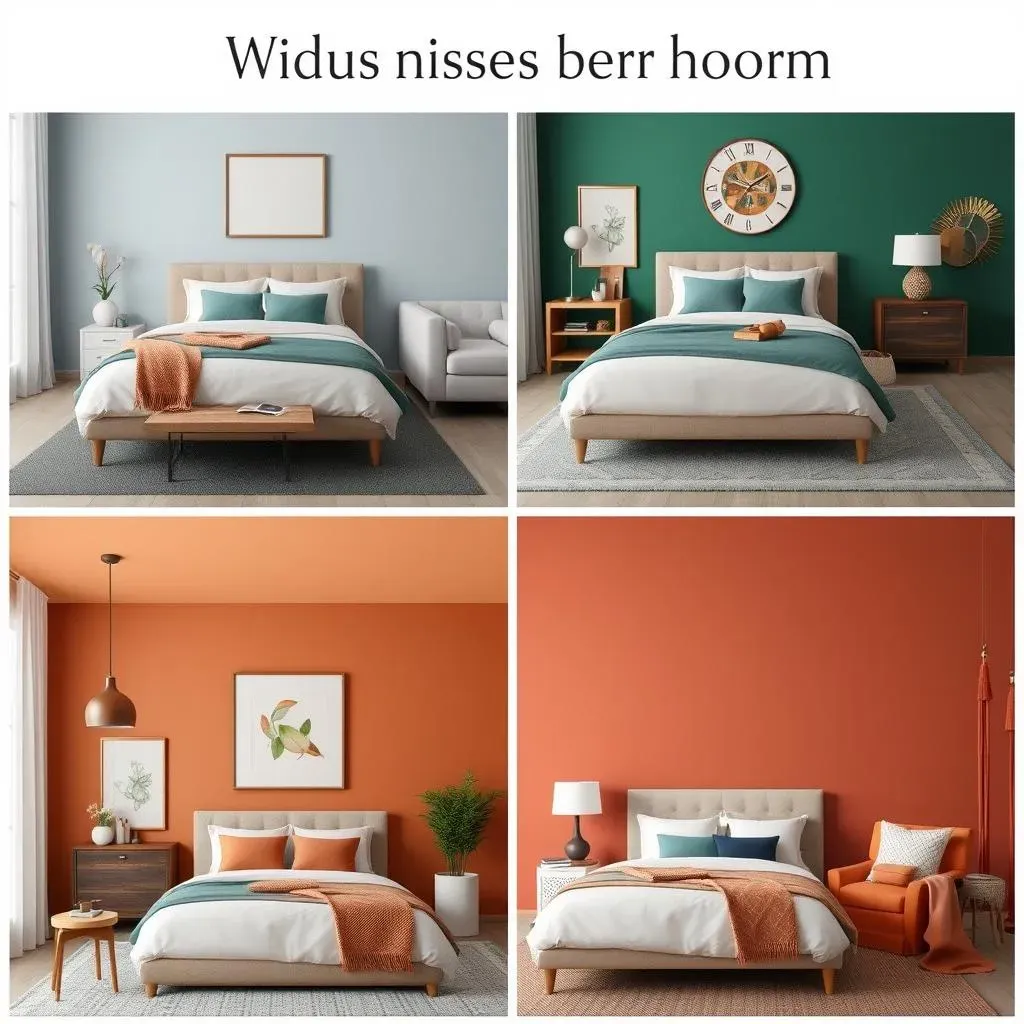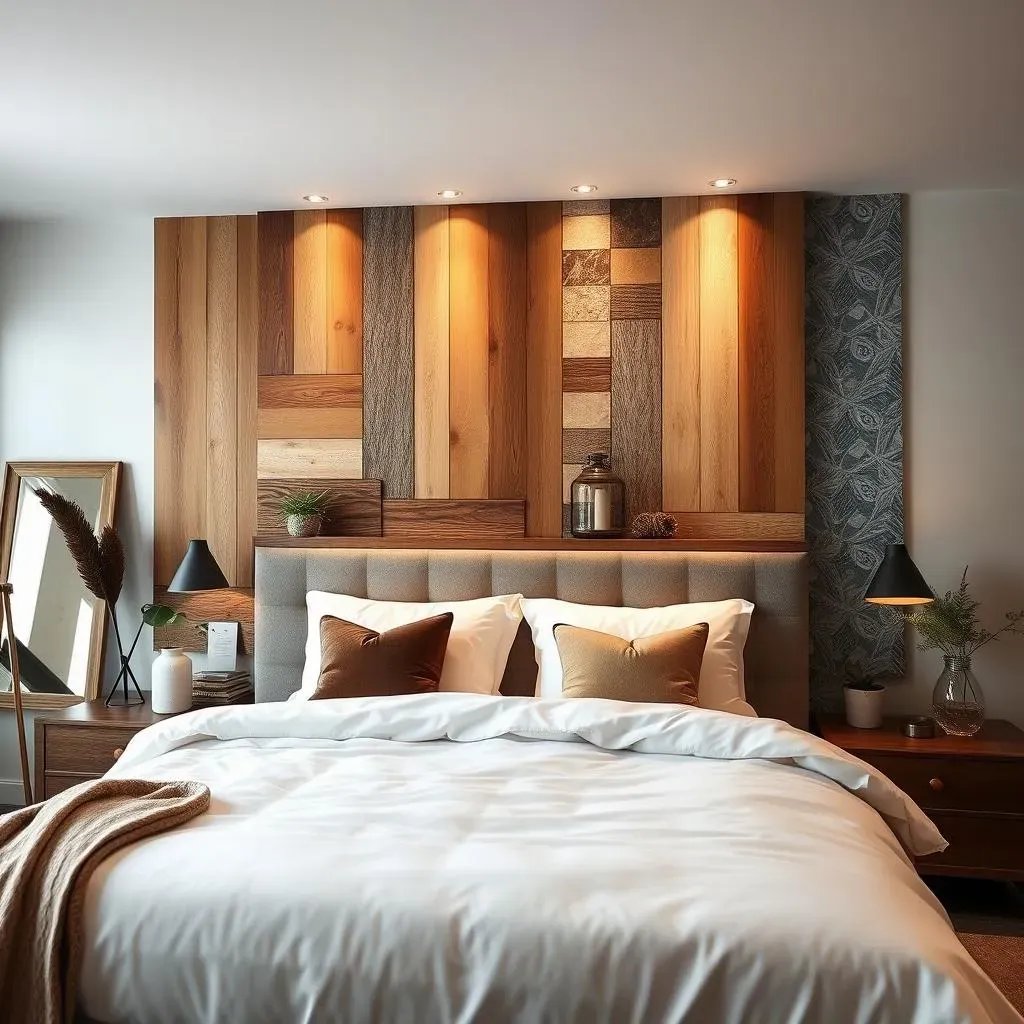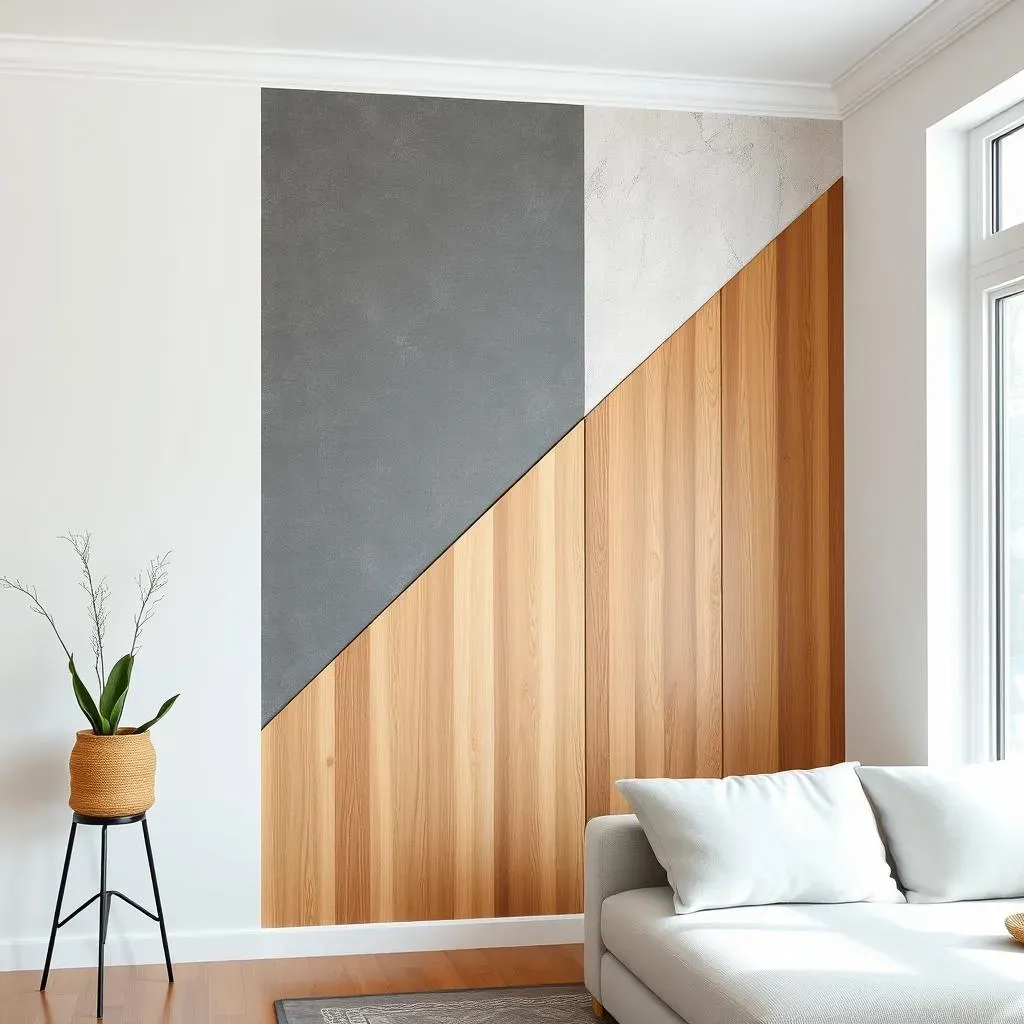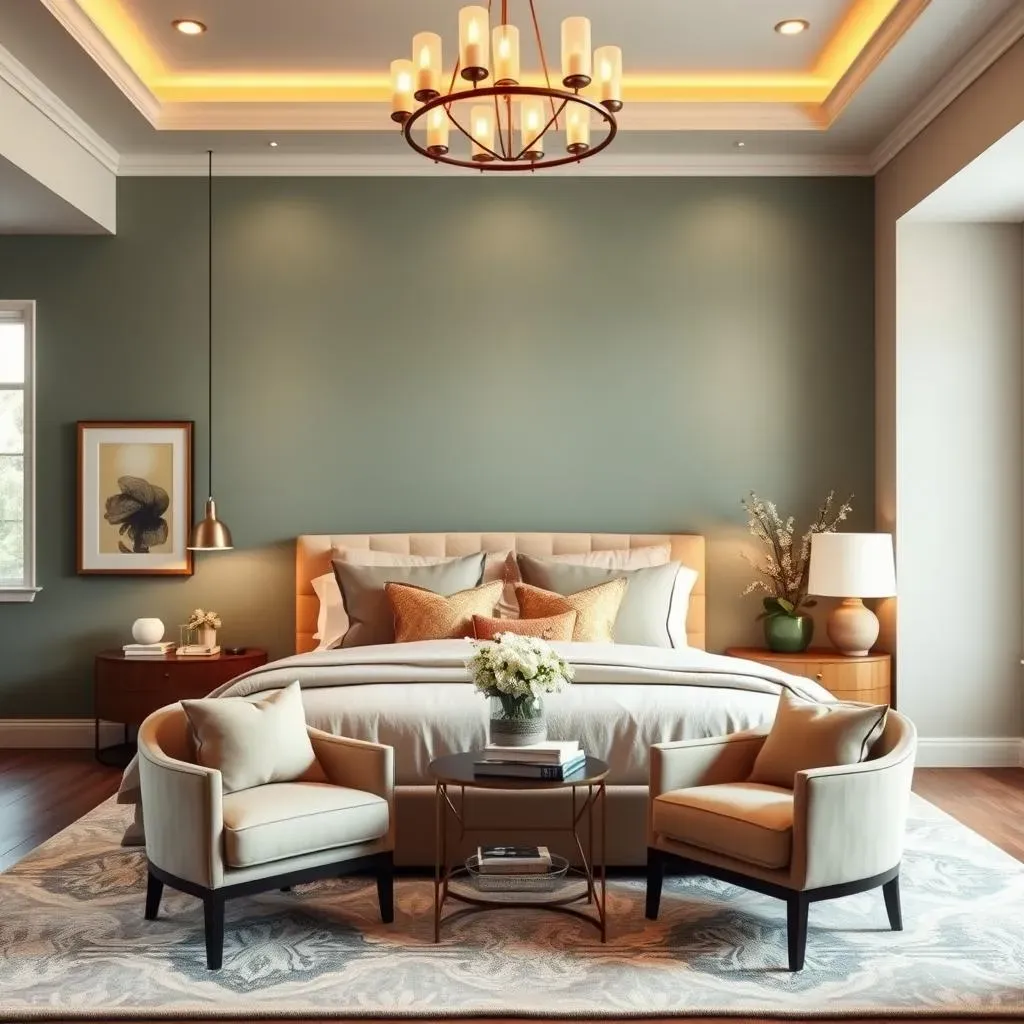Table of Contents
Ready to give your master bedroom a serious style upgrade? Forget boring, plain walls! We're diving headfirst into the exciting world of master bedroom accent wall color ideas. Think of it like this: your bedroom is a blank canvas, and an accent wall is your chance to create a masterpiece. It's not just about slapping on some paint; it’s about crafting a space that reflects your personality and makes you feel amazing every time you walk in. We’ll explore how the right color can totally transform the mood of your room, from calming and serene to bold and dramatic. This isn't just about picking a pretty color; it's about using color to create a focal point that draws the eye and elevates the entire space. We will check out different design ideas that range from simple paint to textured panels, and even some DIY projects you can tackle yourself. So, whether you're looking for a quick and easy change or a full-blown bedroom makeover, get ready to be inspired by some fantastic master bedroom accent wall color ideas. Let's get started and turn that bedroom into your favorite room in the house!
Choosing the Right Color for Your Master Bedroom Accent Wall

Choosing the Right Color for Your Master Bedroom Accent Wall
Mood-Setting Colors
Okay, so you're thinking about an accent wall, that's awesome! First things first: what kind of vibe are you going for in your master bedroom? Colors aren't just pretty; they can actually change how you feel in a space. Want a super chill, spa-like retreat? Think soft blues, gentle greens, or even a calming gray. These colors are like a big, relaxing sigh. On the flip side, if you want something more dramatic and cozy, try rich jewel tones like deep emerald, sapphire, or even a warm, earthy terracotta. These colors add a touch of luxury and can make your bedroom feel like a stylish getaway. Picking the right color is like choosing the right music for a party – it sets the whole tone.
Don't be afraid to experiment a little. Grab some paint samples and stick them on your wall. Live with them for a few days and see how they look in different lighting. A color that looks amazing in the morning might feel totally different at night. Lighting can be a real game-changer.
Considering Room Size and Light
Now, let's talk about your room's size and the natural light. If you have a small bedroom, a super dark accent wall might make it feel even smaller and a bit like a cave, unless that is what you are going for. Instead, try lighter colors. They tend to make spaces appear bigger and airier. Think about it like this: a light-colored wall reflects light, which opens up the room. But, if you've got a bigger bedroom with tons of natural light, you can play with darker or bolder colors. They won't overwhelm the space and can actually add a cozy touch. It’s all about balancing the color with the room’s natural elements.
Also, consider the direction of your windows. If you have a north-facing room, which tends to get cooler, you might want to go with warmer colors to make it feel cozier. South-facing rooms get tons of natural light, so you can experiment with cooler colors without making it feel too chilly. It's all about working with what you've got!
Matching Your Style
Okay, last but not least, let's make sure your accent wall fits your personal style. If your bedroom is all about clean lines and minimalism, a simple, neutral accent wall might be perfect. Think about shades like soft gray, beige, or even a muted white. But, if you're all about bold and funky, don't be afraid to go all out! Try a bright, vibrant color, or maybe even a cool geometric pattern. This is your chance to show off your personality and make the space truly yours.
Think about the other things in your room too. Does your furniture have a specific color? You want your accent wall to complement everything, not clash with it. It's like putting together an outfit; you want all the pieces to work together. So, take a look at your bedding, curtains, and other decor, and pick a color that ties everything together. Remember, it’s your space, so have some fun with it!
Here's a quick guide to help you pick:
Color | Mood | Best For |
|---|---|---|
Soft Blues | Calming, Serene | Relaxing bedrooms, smaller spaces |
Warm Grays | Sophisticated, Neutral | Modern, minimalist bedrooms |
Deep Emerald | Luxurious, Cozy | Larger bedrooms, those with natural light |
Terracotta | Earthy, Grounding | Bedrooms with a bohemian style |
Bright Yellow | Cheerful, Energizing | Bedrooms with minimal light |
Exploring Different Master Bedroom Accent Wall Ideas

Exploring Different Master Bedroom Accent Wall Ideas
Paint Is Not All There Is
Alright, so you've got your color picked out, but hold on a second, there's more to an accent wall than just paint! Don't get me wrong, paint is awesome, it's like the bread and butter of wall decor, but let's think outside the box. We can bring in texture, patterns, and even some natural elements. For example, what about trying a wood paneling accent wall? It adds a warm, rustic feel that's super cozy. You could go for a classic horizontal design or get fancy with a herringbone pattern. It’s like adding a piece of nature right into your bedroom. And if wood isn't your jam, think about wallpaper. There are so many cool designs out there, from geometric shapes to floral patterns, that can give your wall a major upgrade. It’s like giving your wall a fancy new outfit.
Another cool idea is to use textured panels. These aren't your grandma’s wall coverings. We're talking about 3D panels that add depth and dimension to your wall. They can be modern, sleek, or even have a bit of an industrial vibe. It’s like having a piece of art on your wall. And, don't forget about the power of a good old-fashioned gallery wall. Instead of just one color, you could create a focal point using an array of framed prints, photos, or even some cool mirrors. It's all about mixing and matching to create a look that's totally you. So, before you grab that paint roller, let's take a look at some more awesome ideas.
Material | Style | Why it's Cool |
|---|---|---|
Wood Paneling | Rustic, Warm | Adds texture and a natural feel. |
Wallpaper | Versatile, Patterned | Tons of designs to choose from, easy to install. |
Textured Panels | Modern, Sleek | Adds depth and dimension to your wall. |
Gallery Wall | Eclectic, Personal | Showcases your personality and favorite things. |
Geometric Designs and Patterns
Let’s talk about patterns! If you're feeling bold, geometric designs can create a super eye-catching accent wall. Think chevrons, stripes, or even a cool geometric mural. These patterns add a modern and playful touch to your bedroom. It’s like adding a little bit of a puzzle to your wall. You can use paint, wallpaper, or even tape to create these designs. And, if you're feeling super creative, you could try a custom mural. This is your chance to really let your personality shine. Think about your favorite things, your favorite colors, or even a place that you love. You can paint a landscape, an abstract design, or even a cool quote. The possibilities are endless!
Also, don’t overlook the power of simple stripes. Vertical stripes can make your ceiling look higher, while horizontal stripes can make a room feel wider. It’s like using visual tricks to play with your space. You can use different colors for the stripes or even different textures to add some extra flair. It's all about creating a look that’s both stylish and functional. And if you're not feeling super artistic, don't worry! There are tons of stencils and templates out there that can help you create perfect geometric designs, even if you're not a professional artist.
“The details are not the details. They make the design.” - Charles Eames
Natural Elements and Textures
Now, let’s bring nature indoors. Adding natural elements to your accent wall can create a super calming and grounding effect. Think about using natural materials like bamboo, cork, or even stone. These materials add texture and warmth that can make your bedroom feel like a peaceful retreat. You can use bamboo panels, cork tiles, or even create a stone accent wall using faux stone panels. It’s like bringing a bit of the outside in. And if you're not into full-on natural materials, you can try incorporating natural textures. Think about using fabrics like linen, cotton, or even jute. You can hang tapestries, macrame wall hangings, or even create a fabric-covered headboard. It’s all about adding layers of textures to create a cozy and inviting space.
Another awesome idea is to incorporate plants into your accent wall. You can hang planters, create a vertical garden, or even use shelves to display your favorite plants. It’s like creating a little indoor jungle. Plants not only add a touch of nature but also help purify the air, making your bedroom feel fresh and vibrant. So, whether you're into wood, stone, or plants, natural elements can take your accent wall to a whole new level. It's all about creating a space that's both beautiful and relaxing.
- Bamboo panels for a natural, calming feel.
- Cork tiles for a warm, textured look.
- Faux stone panels for a rustic touch.
- Fabric tapestries for a soft, layered texture.
- Vertical gardens for a fresh, vibrant space.
DIY Tips for Creating Your Own Master Bedroom Accent Wall

DIY Tips for Creating Your Own Master Bedroom Accent Wall
Planning and Prep
Okay, so you're ready to get your hands dirty and create your own amazing accent wall? That's fantastic! But hold your horses, before you start slinging paint or unrolling wallpaper, let's talk about planning and prep. This is where you lay the groundwork for a successful project. First, measure your wall carefully. You don't want to end up short on paint or wallpaper, trust me on this. Grab a tape measure and jot down the width and height of the wall you're working on. Then, think about the design you want to create. Are you going for a simple painted wall, or do you have a more complex design in mind? Sketch it out on paper, or use one of those cool design apps to get a visual. This will help you see how your accent wall will look before you start.
Next, gather your materials. Make a list of everything you’ll need – paint, brushes, rollers, tape, wallpaper, adhesive, wood panels, nails, etc. – and make sure you have everything before you start. There’s nothing more annoying than having to stop mid-project to run to the store. Also, don’t forget about prep work. Clean your wall and fill any holes or cracks. Use painter’s tape to protect any trim or edges. Proper prep work is like the secret sauce for a smooth, professional-looking job. It’s a bit boring, but it’s super important. Trust me, it’s worth it in the end!
Painting Techniques and Tips
So, you've decided to go with paint for your accent wall? Awesome choice! It’s a classic for a reason. Now, let's talk about some painting techniques and tips to make sure you get a flawless finish. First, always start with a good quality primer. It helps the paint adhere better and gives you a more even color. Apply the primer in smooth, even strokes and let it dry completely before you start painting. Then, when you're ready to paint, use a good quality brush for the edges and a roller for the larger areas. This will give you a smooth, even coverage. Apply the paint in thin coats, letting each coat dry completely before you apply the next. It’s better to do two or three thin coats than one thick one, which can drip or look uneven.
Also, don't forget about the power of painter’s tape. Use it to create sharp, clean lines between your accent wall and other walls or trim. Press the tape down firmly to prevent paint from bleeding underneath. And, once you’re done painting, remove the tape gently before the paint is completely dry. This will give you a super crisp line. If you’re doing a geometric design, using a level and a measuring tape will be your best friends. It will make sure everything is straight and symmetrical. And don’t be afraid to experiment with different textures. You can use a sponge or a rag to create a textured finish, or even try a faux finish technique. It's all about having some fun and making it your own.
Step | Tip |
|---|---|
Primer | Use a good quality primer for better adhesion. |
Paint | Apply thin coats for an even finish. |
Tape | Use painter's tape for clean lines. |
Techniques | Experiment with different textures and finishes. |
Wallpaper Installation Made Easy
Okay, so maybe paint isn’t your thing and you're thinking about wallpaper. Don’t worry, it’s not as scary as it looks! With a few tips and a little patience, you can totally rock a wallpaper accent wall. First, make sure your wall is smooth and clean. Remove any old wallpaper or loose paint, and fill any holes or cracks. Then, measure your wall and cut your wallpaper to size, leaving a little extra on the top and bottom. This is like your safety net in case the wall isn't perfectly straight. Apply the wallpaper adhesive to the back of the wallpaper, or directly to the wall if you are using pre-pasted wallpaper. Follow the manufacturer's instructions carefully, because each type of wallpaper can be a bit different.
Next, align the wallpaper carefully on the wall, starting at the top and working your way down. Use a smoothing tool to get rid of any air bubbles and make sure the wallpaper is flat against the wall. Work slowly and carefully, making sure each section aligns perfectly with the previous one. Once you’ve got your wallpaper up, use a sharp utility knife to trim off any excess wallpaper at the top and bottom. And if you’re using patterned wallpaper, make sure the pattern lines up correctly, this can be tricky. Don't worry if you make a mistake; you can always pull it off and try again. It's all about practice and patience. Wallpaper can be a bit tricky, but the end result is totally worth it.
“Have no fear of perfection – you’ll never reach it.” - Salvador Dali
Wood Paneling Tips and Tricks
If you’re feeling a bit adventurous, let’s talk about wood paneling. It’s a great way to add texture and a rustic touch to your accent wall. First, you’ll need to decide what type of wood you want to use. You can go for classic planks, shiplap, or even a more modern geometric design. Measure your wall and cut your wood panels to size. You can use a saw or have them cut at the hardware store. Then, you’ll need to attach the wood panels to the wall. You can use construction adhesive or nails, or both, depending on the type of panels you are using. Start by placing the first panel at the top of the wall, making sure it’s level. Then, continue adding panels, making sure each one lines up with the previous one.
If you’re doing a more complex design, like a herringbone pattern, you might need to use a level and a measuring tape to make sure everything is aligned correctly. And, if you want to give your wood paneling a more finished look, you can stain it or paint it. This is your chance to add your personal touch and create a look that’s totally unique. Wood paneling can be a bit more challenging than paint or wallpaper, but the end result is a beautiful, textured accent wall that's definitely worth the effort. Just take your time, follow the instructions, and don't be afraid to ask for help if you need it. You got this!
- Choose the right type of wood for your style.
- Measure and cut your panels carefully.
- Use construction adhesive and/or nails.
- Stain or paint your wood for a finished look.
